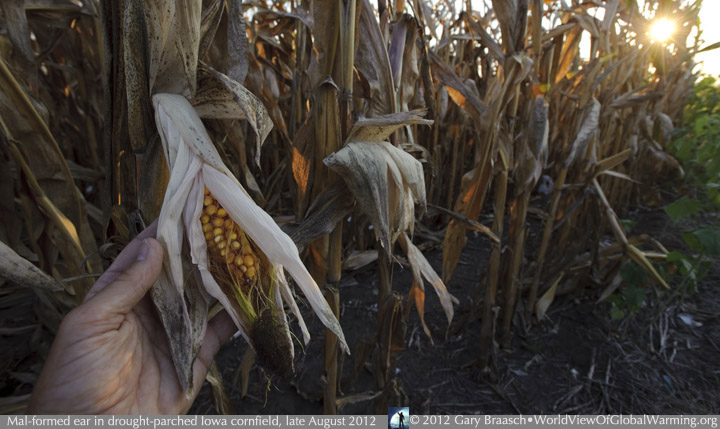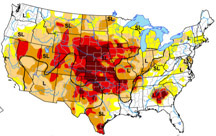Climate Photo of the Week
"The corn is as high as an elephant's eye" ... not this year, as drought takes its toll.
More then three quarters of the lower 48 states remains in a state of abnormally dry to very extreme drought past the middle of September, continuing to mark 2012 as comparable to some of the worst droughts in the past century. The year is on track to be the hottest ever recorded since 1888 in the United States. The areas of extreme and exceptional drought -- the worst two dry conditions in the US Drought Monitor -- cover more than 20 percent of the nation, despite rains from Hurricane Isaac and other storms. Iowa, Nebraska, Kansas, Oklahoma, Arkansas and parts of the Rockies remain brutally dry, and one result is a 13 percent reduction in US corn crop.
Powerful droughts have raged across North America for centuries, and the current drought is not as severe as some of those. But scientists studying the previous drought of 2000-2004 found it was the most severe in 800 years, surpassing the Dust Bowl days. Based on a research paper in the journal Nature-Geoscience, they write: "Planetary warming, in turn, is expected to create drier conditions across western North America, because of the way global-wind and atmospheric-pressure patterns shift in response. Indeed, scientists see signs of the relationship between warming and drought in western North America by analyzing trends over the last 100 years. ...The current drought plaguing the country is worryingly consistent with these expectations." Other scientists are actively investigating the link between global warming and drought. Also see our previous post, which reports on a study linking the severity of last year's Texas drought to climate change.
This month, World View of Global Warming witnessed drought effects across Iowa, NW Missouri, Nebraska and Kansas. During late summer when corn should be high and dark green, heavy with the large uniform ears of corn for which the region is famous, we saw instead vast landscapes colored brown, yellow and light green. Farmers complained of lack of any rain after May, or too little rain and too late for the corn kernels to develop well, not to mention record heat. The quality of the crop varied so much even within single fields that farmers couldn't guess what the yield would be. "We'll be lucky to break even," said a farmer in Adair, Iowa. The Department of Agriculture Weekly Weather and Crop Bulletin reported that even though four percent more corn acreage was planted this year, total production will be 13 percent lower and the average yield will be the lowest since 1995. Please see more text and photo-story.
COPYRIGHT NOTICE:
Photography and text Copyright © 2005 - 2017 (and before) Gary Braasch All rights reserved. Use of photographs in any manner without permission is prohibited by US copyright law. Photography is available for license to publications and other uses. Please contact requestinformation@worldviewofglobalwarming.org. View more of Gary Braasch's photography here.




